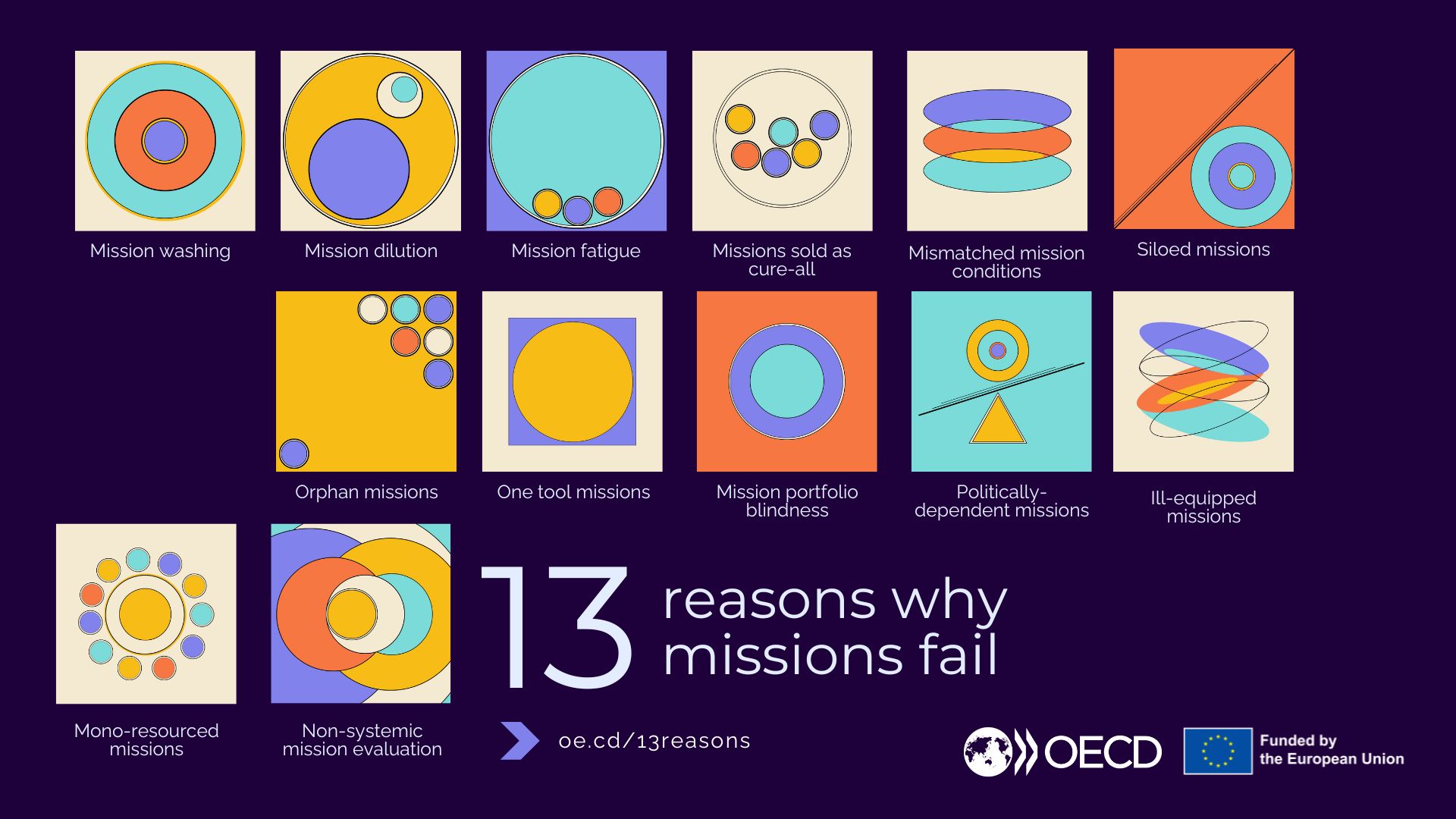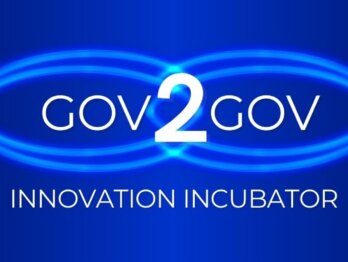13 reasons why missions fail

This blog post was authored by experts from the OECD Mission Action Lab, a joint initiative of the OECD Directorate for Science, Technology and Innovation, the OECD Directorate of Public Governance and the OECD Development Co-operation Directorate.
It has been 10 years since Professor Mariana Mazzucato’s influential book “Entrepreneurial State” came out. It has inspired the European Union, states, agencies, regions, and cities around the globe to launch missions and mission-oriented policies (and yes, these are different – read more from our blog here). This flurry of activity has led to a wave of different types of mission-oriented approaches (bottom-up, top-down, outsourced etc.) all with the aim of solving complex challenges and achieving goals that have long remained out of reach. And in turn, the concept has generated both enthusiasm as well as a fair share of skepticism. If you excel at basic research or have been supporting the diffusion of existing technologies for years, would you want to see funding being driven by societal challenges? Probably not.
With heightened societal scrutiny, missions – and the approach itself – need to prove themselves quickly. Even if most missions are at their infancy or at best early childhood, everyone wants to see rapid results. This arguably puts the concept at risk. At the OECD Mission Action Lab, we see value in missions – if done right. But there are also a lot of pitfalls to avoid which devalue the concept to no fault of its own. Talking about those pitfalls is important as early evaluations of mission-oriented policies are underway. It is important to be objectively critical of missions, but also acknowledge the underlying reasons behind these challenges.[1]

Looking into the pitfalls
The OECD Mission Action Lab critically examines the practice of missions and mission-oriented policies as well as their suitability to different problem contexts. Addressing complex challenges comes first, methods come second. The Lab is, thus, not promoting “missions” as the one and only instrument to address complex problems or societal transitions. Rather, we aim to understand when and how mission as an approach to public policies is useful and, sometimes more importantly, when it is not.
Based on the activities and research conducted by the Mission Action Lab at the OECD, there are several areas where we fear that missions are in danger of under-delivering on their ambitious promise. In some cases, missions may not be the right approach to begin with; while in others, more commitment to missions is needed. These are reoccurring pitfalls which mission-oriented policies often fall into:
- Mission washing. A strong international push (and funding) for mission-oriented policies has led countries to adopt the terminology, rather than changing how they, at their core, structure and deliver on policies. Many policy initiatives are retrofitted incrementally to better adhere to mission concepts, but often without meaningful change to their content. They fund the same activities with the same frameworks and same uncoordinated governance structures, and then claim what they do in the priority sectors is in the name of the mission. Not only is it less likely to deliver expected impacts, but mission washing also sends the wrong signal to the system, hindering policy learning.
When mission washing occurs, it is unreasonable to expect significantly different outcomes on complex challenges. This will invariably bring about a pushback on the concept of missions itself. Hence, more clarity and stress-testing about what justifiably qualifies as a mission is required to eventually be able to meaningfully assess their effectiveness. In the international development sector as well, there is increasing interest in mission-oriented innovation and with it an increased risk that traditional ways of providing development assistance are retrofitted as missions. - Mission dilution. Maybe the greatest risk to mission-oriented policies is a natural tendency for their scope to expand without the equivalent increase of resources and authority. Why go through the trouble of setting well-defined climate mitigation targets within specific sectors or area if we can just have a diffuse mission paying lip-service to the whole economy becoming carbon neutral? This, however, reduces levels of directionality and concreteness of action. Ambiguity paralyzes. Broad and ambitious mission statements are laudable, but they also require a more important levels of commitment, resources of support. They also entail higher degrees of complexity; wider co-ordination entails negotiation on shared interests, which can result in an agreement on the lowest common denominator and/or too broad objectives. While inclusiveness and broad-based buy-in is often seen as key success indicators for missions, mission ambition and central targets need to be maintained, while enlisting new actors and getting political support for missions.
- Mission fatigue. The systemic nature of missions can lead to an inflation of strategic documents, meetings, and monitoring processes, when one tries to cross all dimensions: sectoral, disciplinary, transversal, at various strategic, programming, and operational levels. There is a lot to report on and less time to actually do. Mission fatigue can also be the result of changing political priorities or newly emerging challenges, such as the COVID-19 pandemic impacted investments in existing missions as funding and other resources were redirected due to new priorities.
- Missions as cure-all. Missions – targeted, time-bound, integrated, societal challenge centric approaches – do not fit all policy areas or even goals. The comparative advantage(s) of mission-oriented policy approaches need to be explored. In some contexts, and for some challenges, missions may not be the right approach (e.g., where the domain is quickly changing, and the societal challenges are still emerging; or there is no political will to set clear, timebound targets). There is, thus, a need to analyse in which areas missions are genuinely advantageous. In areas ripe with wicked problems (where the landscape is continuously moving and new issues arise), is a mission-oriented approach the best way to tackle the challenges or will it introduce too much lock-in?
- Mismatched mission conditions. As previously touched upon, policymakers don’t always walk the talk when it comes to missions. Often missions are adopted into existing governance structures rather than allowing mission-specific governance frameworks to emerge (e.g., managers’ incentives, budgetary mechanisms, skills and practices, etc.). Mission managers then struggle to work across existing structures, budget lines, and power divisions.
It is unclear what the necessary and sufficient conditions are that create the right environment to implement a mission-oriented approach. Connected to the competitive advantage of missions, it is also currently unclear which conditions are prerequisites to make a mission-oriented approach successful. How, for example, should one assess the strength of co-ordination capabilities, organisational flexibility, innovation capacity and their impact on the suitability of a mission-oriented innovation approach? This is especially true for a wide range of cases in international development. Countries and their domestic innovation ecosystems and policy environments need to have a certain mission-readiness as a precondition for this approach to enable comparative advantage and, ultimately, impact. - Siloed missions. Missions, at least in the most high-income countries, have been strongly led by the Science, Technology and Innovation (STI) community. STI policymakers have played a significant role in championing the mission-oriented approach in their systems, often facing strong headwind. Most academic literature on the topic also originates from the innovation research community. Hence, most activities seem to be stationed around STI and its associated stakeholders and funders. Yet, in most cases mission success depends on the involvement of much a broader range of stakeholders, , like those responsible for sectoral regulation, infrastructure, skills, and agencies, and even behavioural insights. We call this the ‘STI only trap’, but it can beyond that one particular domain. Other missions led by ministries of health, environment and other actors are also emerging, but they are likewise bound by their silos, making it difficult to co-ordinate actions across different policy domains – especially when they have lower STI budgets. Hence, both in action and in research, missions need to be brought out of silos. The novelty of the mission approach lies in no small part its promise to harness a spectrum of policy actors and levers, combining both supply and demand side interventions.
- Orphan missions. Cross-government missions might find themselves without a clear responsible “parent”. Policymakers need to devise clear ways to assign ownership and responsibility over missions and resulting interventions. It remains to be seen which organisational forms and resourcing approaches (HR, budgetary etc.) work best in a mission-oriented context to encourage collaboration across government domains and sectors, without compromising on clear roles and mandates. The current practice tends to point to the fact that either the responsibility disappears between various stakeholders or is hoarded by actors not having access to all levers of change needed to deliver on the missions. Traditional governance and management principles, such as clear responsibility and accountability, still apply in a mission context.
- One–tool missions. Missions, in the way they are currently implemented, often only rely on the policy instruments that the entity responsible for the mission owns or has at its disposal: line agencies on funding calls, ministries with regulatory powers on drafting laws etc. This means that missions often lack a broad enough toolkit to actually fulfil their theory of change and reach the mission goals. For example, in the STI space strong divisions between supply- and demand-driven approaches exist. Yet, without strong market-creating components creating a “technology pull” effect, such policies remain within the confines of previous generations of traditional “technology push” STI policy.
- Mission portfolio blindness. Frequently mission managers do not have the time to properly invest in their initial theory of change or systemic intervention logic. Everything that might have an impact on the mission objectives – whether or not it is within or outside mission managers’ control – is mapped and mentioned as contributing to the success of the mission. But do different mission activities capitalise on the synergies between actions, close the gaps in the theory of change, reach the scale to make a difference – actual deliver on the mission? In the mission space, this portfolio perspective is still missing, and mission managers do not have an actionable overview of how all envisioned activities contribute to the mission goals.
- Politically-dependent missions. Even if most missions cross political cycles in their delivery timelines, they often do not prepare strategically for shifting political winds. As much as possible, missions need to be future- and politics-proofed. Missions, by nature, are far from insulated from politics; they are very much subject to its whims. They do not fit neatly into 3–4-year political cycles. Resilience to various political contexts is a factor to be taken into account in their design. History suggests that an important success factor for missions in a democratic context is the support they are able to garner across the political aisle and through a government transition. But what are the most important factors for it?
- Ill-equipped mission teams. To work in a mission-oriented way mission teams need specific skills, mindsets, and tools. More often than not, a mission is adopted at the highest strategic level with little consideration required for the skills, tools and capabilities needed of the mission team. Concepts run ahead of actualand methodologies of implementation and thus, the work is pushed down traditional delivery lines (e.g., procurement orbudgeting) that are unable to work in new ways. Mission implementation has a long way to go, and more robust knowledge is needed on the tools needed to plan (e.g., theories of change, roadmaps, etc.), implement (e.g., portfolio strategy and knowledge infrastructure) and evaluate (e.g., systemic evaluation methods and practices – see below). There is also a need for new ways to create synergies with initiatives across mission portfolios and to ensure that targets are genuinely reached. This particularly applies to public sectors in high-income countries and to the interplay of public sector entities and international development actors in medium and low-income countries.
- Under-resourced missions. When it comes to ambitious societal challenges, governments simply do not have sufficient funds. Missions require the ability to mobilise up- and downstream public resources, as well as effectively leverage of private sector funding. Cross-sectoral funds become more numerous but are still not the norm. More generally, missions have used very little financial innovation so far and remain funded by the different instruments they are embedded within. Working across the ecosystem towards mission success is still a novel concept for government and doing it effectively even more so. For example, the split between regional and national responsibilities and budgets in federal systems can create structural challenges which are difficult for missions to bridge. Furthermore, the projectification of significant parts of public sector initiatives and of international development assistance is a hindrance to supporting the implementation of a medium-term mission and the need to have flexible financing instruments that support non-linear, adaptive ways of working.
- Non-systemic mission evaluation. As written about 20 years ago, ‘a systems world needs systems evaluations’[2]. Given the challenge it represented to venture into this new policy approach, missions have often been started without much thought on their monitoring and evaluation. Missions need to be evaluated to test if they actually work. This should include evaluating and monitoring for the pitfalls covered above. There is an urgent need to develop evaluation frameworks, tools and related skills that take into account the directional and systemic nature of missions and exchange results and good practices of mission evaluations.
Working across all country typologies, from high, middle to low-income countries, OECD Mission Action Lab research has identified these as the critical mission-related pitfalls. Some of these pitfalls are specific to high-income countries, where most self-avowed missions have been set up and are being implemented, some are relevant for all contexts, while others are specific to low-income country contexts. Over the following two years as missions around the world begin to mature, the Lab will focus its work on addressing these issues, including through the following initiatives:
- The Mission Action Lab’s modular boot camp, which helps practitioners to examine their ecosystem, stress-test their mission, and examine the capacities needed to deliver on ambitions. If you are interested in the boot camp resource or would like to run it on your mission with the OECD, please get in touch.
- The Lab’s mission diagnostic methodology, which examines ongoing missions, their progress and alignment with general mission design principles.
- Research on mission governance, mission evaluation and portfolio approaches for missions, which will be jointly conducted by the Lab and the European Commission. The aim is to develop actionable guidelines across all mentioned areas that mission managers can apply in practice.
- A 2024 OECD report on governing transitions, which will analyse the relevance of mission-oriented approaches to the governance of national climate transitions.
On 26th of March 2024 we will also launch a community of practice to jointly examine these issues and push back against the pitfalls. If you are interested in working together with us and joining the community, please fill out this short form.
This project and blog are funded by the European Union. Its contents are the sole responsibility of the authors and do not necessarily reflect the views of the European Union.

[1] This blog is based on OECD’s mission-oriented research and you can find more information here: https://oecd-opsi.org/publications/tackling-policy-challenges/ and https://www.oecd.org/sti/inno/the-design-and-implementation-of-mission-oriented-innovation-policies-3f6c76a4-en.htm
[2] Arnold, E., 2004. Evaluating research and innovation policy: a systems world needs systems evaluations. Research evaluation, 13(1), pp.3-17.












